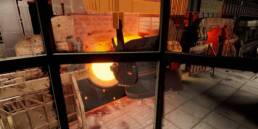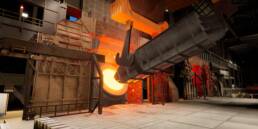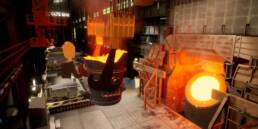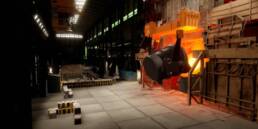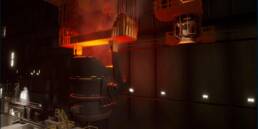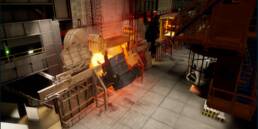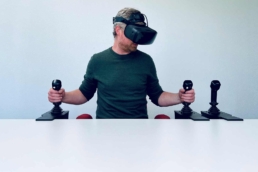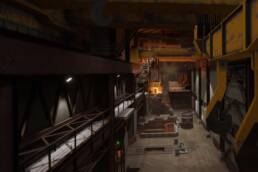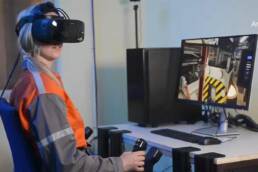Fewer risks, safer workers with advanced VR training for crane operators
A case study about how Tata Steel at Port Talbot implemented our first Steel Industry Virtual Reality simulator to train new crane operators. Decreasing total training time and improving overall plant-site safety. Note: This first simulator was the predecessor of what we now call our Steel Sim VR simulators.
Training is one of the biggest challenges in our steel shop
Heavy industry job sites can be aggressive and hazardous environments. These job sites change every day. And what was safe yesterday can be potentially very dangerous the next? Training can be a challenge in such environments. How does a company like Tata Steel train its workforce and avoid any danger? Together with Steel Sim VR (formerly known as BLUF), Tata Steel implemented a Virtual Reality training program for crane operators with major benefits.
The North Charging Crane of the BOS plant at the Port Talbot steel works was installed in 1969 when the plant was built. In 2020 the crane will be completely replaced. This drastically changes the way drivers operate the crane and they will have to develop new driving techniques and habits.
‘’One of our biggest challenges when the crane is installed, will be training. Since this is a very aggressive and potentially dangerous environment full of hazards. We found that training on the real crane would have a lot of risks itself. Furthermore, we need to take a crane out of operation and that drastically decreases the amount of steel we can make. If we could train in an environment away from the operation and any hazards, doing the same job, we could take a lot of risks away for the production, our crane operators, and plant personnel as well.’’ – Thomas Badger Electrical Engineer Tata Steel
Improved safety, building muscle memory and confidence, decreased total training time
‘’The main thing that we achieve within the training is muscle memory. Building confidence in the new controllers of the new crane. So, when operators face a problem, they react without thinking. What we want to get out of it is a seamless transition for operators on the new crane,’’ added Thomas.
The simulator is extremely realistic; for instance, even a ladle breakout can be simulated at any time during the training. Torpedo trains with liquid steel are coming in and out of the plant, and even the convertor can be controlled with extreme precision. ”With this Virtual Reality Training Tata Steel is going to cut out training time while production continues,’’ said Wilco de Ruiter – Co-Founder of Steel Sim VR
‘’We are trying to get a bit of a culture change within the steel industry on how we use 3D environments and how we train as well. I’d like to think this VR training is a stepping stone towards that. Training our employees in a safe environment before releasing them into a potentially hazardous environment will reduce the risk to our employees.’’ – Thomas Badger.
More from our blog
4 March 2024
Exploring 10 key factors that impact the ROI for VR Crane Training
10 primary factors influencing Return On Investment In the dynamic landscape…
20 November 2023
Tata Steel is paving the way for a safer future for industrial training.
Article credits to Varjo – read original here Shaping the future of steel…
27 June 2022
Crane simulators for ArcelorMittal Gent as a high-tech training tool
Onboarding challenges The job of onboarding new crane operators is becoming…
